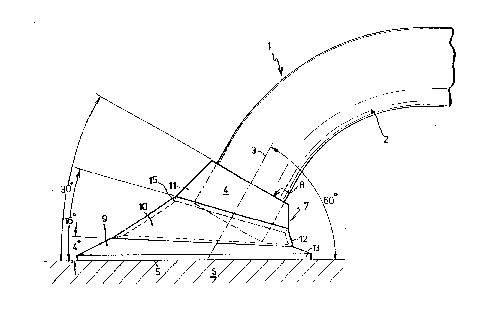Une partie des informations de ce site Web a été fournie par des sources externes. Le gouvernement du Canada n'assume aucune responsabilité concernant la précision, l'actualité ou la fiabilité des informations fournies par les sources externes. Les utilisateurs qui désirent employer cette information devraient consulter directement la source des informations. Le contenu fourni par les sources externes n'est pas assujetti aux exigences sur les langues officielles, la protection des renseignements personnels et l'accessibilité.
L'apparition de différences dans le texte et l'image des Revendications et de l'Abrégé dépend du moment auquel le document est publié. Les textes des Revendications et de l'Abrégé sont affichés :
| (12) Brevet: | (11) CA 2058998 |
|---|---|
| (54) Titre français: | POIGNEE |
| (54) Titre anglais: | HANDLE |
| Statut: | Périmé et au-delà du délai pour l’annulation |
| (51) Classification internationale des brevets (CIB): |
|
|---|---|
| (72) Inventeurs : |
|
| (73) Titulaires : |
|
| (71) Demandeurs : |
|
| (74) Agent: | KIRBY EADES GALE BAKER |
| (74) Co-agent: | |
| (45) Délivré: | 2001-01-16 |
| (86) Date de dépôt PCT: | 1990-11-06 |
| (87) Mise à la disponibilité du public: | 1991-05-16 |
| Requête d'examen: | 1997-07-30 |
| Licence disponible: | S.O. |
| Cédé au domaine public: | S.O. |
| (25) Langue des documents déposés: | Anglais |
| Traité de coopération en matière de brevets (PCT): | Oui |
|---|---|
| (86) Numéro de la demande PCT: | PCT/NL1990/000168 |
| (87) Numéro de publication internationale PCT: | NL1990000168 |
| (85) Entrée nationale: | 1991-12-12 |
| (30) Données de priorité de la demande: | ||||||
|---|---|---|---|---|---|---|
|
On décrit une poignée (1), conçue notamment pour les toilettes destinées aux personnes infirmes ou partiellement infirmes. La poignée (1) comporte un élément de poignée sensiblement oblong (2) possédant de chaque côté un moyen de fixation comportant une surface de fixation (5). A proximité de chaque extrémité (4) dudit élément de poignée (1), son axe central se trouve à un angle sensiblement inférieur à 90° par rapport à la surface de fixation (5).
Described is a handle (1), in particular: for sanitary conveniences intended
for invalids and partial invalids. The handle (1)
comprises a substantially oblong handle portion (2) having on either side a
fastening means with a fastening surface (5). Near
each end (4) of the handle (1) portion its central axis is at an angle with
the fastening surface (5) of substantially less than 90°,
Note : Les revendications sont présentées dans la langue officielle dans laquelle elles ont été soumises.
Note : Les descriptions sont présentées dans la langue officielle dans laquelle elles ont été soumises.

2024-08-01 : Dans le cadre de la transition vers les Brevets de nouvelle génération (BNG), la base de données sur les brevets canadiens (BDBC) contient désormais un Historique d'événement plus détaillé, qui reproduit le Journal des événements de notre nouvelle solution interne.
Veuillez noter que les événements débutant par « Inactive : » se réfèrent à des événements qui ne sont plus utilisés dans notre nouvelle solution interne.
Pour une meilleure compréhension de l'état de la demande ou brevet qui figure sur cette page, la rubrique Mise en garde , et les descriptions de Brevet , Historique d'événement , Taxes périodiques et Historique des paiements devraient être consultées.
| Description | Date |
|---|---|
| Le délai pour l'annulation est expiré | 2002-11-06 |
| Lettre envoyée | 2001-11-06 |
| Inactive : Page couverture publiée | 2001-02-08 |
| Inactive : Acc. récept. de corrections art.8 Loi | 2001-02-08 |
| Inactive : Correction - Doc. d'antériorité | 2001-02-08 |
| Accordé par délivrance | 2001-01-16 |
| Inactive : Page couverture publiée | 2001-01-15 |
| Inactive : Taxe finale reçue | 2000-10-11 |
| Préoctroi | 2000-10-11 |
| Lettre envoyée | 2000-04-26 |
| Un avis d'acceptation est envoyé | 2000-04-26 |
| Un avis d'acceptation est envoyé | 2000-04-26 |
| Inactive : Approuvée aux fins d'acceptation (AFA) | 2000-01-11 |
| Inactive : Acc. réc. RE - Pas de dem. doc. d'antériorité | 1997-09-18 |
| Inactive : Renseign. sur l'état - Complets dès date d'ent. journ. | 1997-09-11 |
| Inactive : Dem. traitée sur TS dès date d'ent. journal | 1997-09-11 |
| Toutes les exigences pour l'examen - jugée conforme | 1997-07-30 |
| Exigences pour une requête d'examen - jugée conforme | 1997-07-30 |
| Demande publiée (accessible au public) | 1991-05-16 |
Il n'y a pas d'historique d'abandonnement
Le dernier paiement a été reçu le 2000-09-11
Avis : Si le paiement en totalité n'a pas été reçu au plus tard à la date indiquée, une taxe supplémentaire peut être imposée, soit une des taxes suivantes :
Les taxes sur les brevets sont ajustées au 1er janvier de chaque année. Les montants ci-dessus sont les montants actuels s'ils sont reçus au plus tard le 31 décembre de l'année en cours.
Veuillez vous référer à la page web des
taxes sur les brevets
de l'OPIC pour voir tous les montants actuels des taxes.
| Type de taxes | Anniversaire | Échéance | Date payée |
|---|---|---|---|
| Requête d'examen - générale | 1997-07-30 | ||
| TM (demande, 7e anniv.) - générale | 07 | 1997-11-06 | 1997-10-29 |
| TM (demande, 8e anniv.) - générale | 08 | 1998-11-06 | 1998-10-22 |
| TM (demande, 9e anniv.) - générale | 09 | 1999-11-08 | 1999-10-19 |
| TM (demande, 10e anniv.) - générale | 10 | 2000-11-06 | 2000-09-11 |
| Taxe finale - générale | 2000-10-11 |
Les titulaires actuels et antérieures au dossier sont affichés en ordre alphabétique.
| Titulaires actuels au dossier |
|---|
| B.V. LINIDO |
| Titulaires antérieures au dossier |
|---|
| CASPER JACOBUS FRANCISCUS DE JONGE |
| FRANCISCUS JITTE MARIA NIEUWENHUIS |